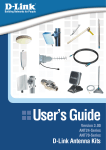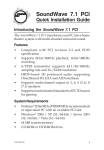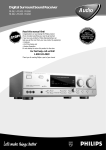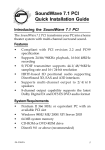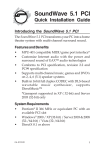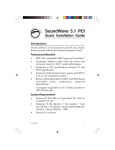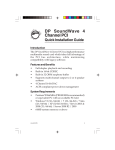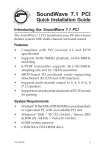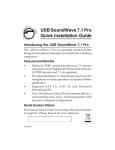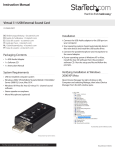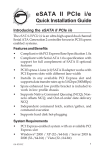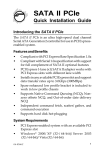Download Siig SoundWave 7.1 PCI
Transcript
SoundWave 7.1 PCI Quick Installation Guide Introducing the SoundWave 7.1 PCI The SoundWave 7.1 PCI transforms your PC into a home theater system with multi-channel surround sound. Features • • • • • • High-definition 7.1 surround sound transforms your PC into a home theather system Conforms to PCI specification, revision 2.2 and PC99 specification Supports 24-bit/96KHz playback, 16-bit/48KHz recording S/PDIF transmitter supports 44.1/48/96KHz sampling rate and 16-/24-bit resolution Supports multi-channel output to 2, 4, 6 (5.1), 8 (7.1) speakers Supports most industrial standards of PC 3D sound for gaming System Requirements • • • • Pentium® II 266 MHz (PIII 800 MHz recommended) or equivalent PC with an available PCI slot Windows® 7 (32-/64-bit) / Vista (32-/64-bit) / XP (32-/64-bit) / Server 2003 & 2008 (32-/64-bit) / 2000 64 MB system memory CD-ROM or DVD-ROM drive 04-0501C 1 Package Contents • • • SoundWave 7.1 PCI Software CD (Xear 3D) Quick Installation Guide Layout Aux-in CD-in PC speaker-in Optical In/Out CD-S/PDIF-in Figure 1: Layout 2 Line In Mic In *Front * Rear * Surround Out Out Out * Center/Subwoofer S/PDIF Out Figure 2: External Connectors *Note: Must use all four connectors to get the full 7.1 surround sound. External Connectors Line In (Blue): This is a stereo line-level input that can be used to record into an audio recording program. Mic In (pink): The mic input allows you to connect a mono microphone for recording, videophone or voice recognition applications. 3 Front Out (green): This jack should connect to powered left and right speakers located to the left and right of your computer monitor. If you have a two speakers stereo setup, this is the jack to use. You can also plug a pair of stereo headphones into this jack. Rear Out (black): This line-level output should be connected to powered Left and Right Surround speakers. These speakers should located to your left and right sides, behind your head. Surround Out (black): This line-level output connects to powered left and right center support channel speakers. These speakers should be located directly to your left and right sides as you are looking at your computer monitor. Center/Subwoofer (orange): This line-level output connects to powered Center and Subwoofer speakers. The Center channel speakers should be directly above or below your monitor and the subwoofer can just go about anywhere it will fit in your room. S/PDIF Out: The Digital Output jack is a S/PDIF Coaxial output you can use with an RCA cable to connect to a digital recorder, mixer or surround receiver. A 75 Ohm digital coaxial cable is required for this type of connection. 4 Hardware Installation General instructions for installing the card are provided below. Since the design of computer cases and motherboards vary, refer to your computer reference manual for further information, if needed. Static Electricity Discharge may permanently damage your system. Discharge any static electricity build up in your body by touching your computer case for a few seconds. Avoid any contact with internal parts and handle cards only by their external edges. 1. 2. 3. 4. 5. 6. 7. Turn OFF the power to your computer. Unplug the power cord and remove your computer cover. Remove the slot bracket from an available PCI slot. Carefully align the card to the selected PCI slot, push the board down firmly, but gently, until it is well seated. Replace the slot bracket holding screw to secure the card. Connect one end of the audio cable from your CD-ROM or DVD-player to the CD-In or Aux-In on the soundcard. Replace the computer cover and reconnect the power cord. Driver Installation Windows 7 1. 2. After installing the board boot up Windows. Insert the software CD, click Start, in the Start Search box,type X:\Vista\Setup.exe, press Enter. (Replace X: with the drive letter of your CD-ROM) 5 4. Choose Yes, I want to restart my computer now, then click Finish. Windows Server 2008 / Vista™ 1. 2. 3. 4. After installing the board boot up Windows. At the new Add New Hardware Wizard, click Cancel. Insert the software CD, click Start, in the Start Search box,type X:\Setup.exe, press Enter. (Replace X: with the drive letter of your CD-ROM) Choose Yes, I want to restart my computer now, then click Finish. Windows Server 2003 / XP / 2000 1. 2. 3. 4. 5. 6 After installing the board boot up Windows. At the new Add New Hardware Wizard, click Cancel. Insert the software CD, Autorun should start the installation automatically. If Autorun does not start, click Start, Run. Type X:\Setup.exe, then click OK. (Replace X: with the drive letter of your CD-ROM) Click Next, Next, Next. Choose Yes, I want to restart my computer now, then click Finish. To Verify Windows Installation 1. Check Device Manager to verify installation. For Windows 7: Right click Computer, click Manage. For Windows Vista: Right click Computer, click Manage, click Continue. 2. 3. For Windos Server 2008: Right click Computer, click Manage, double click Diagnostics. For Windows Server 2003/ XP / 2000: Right click My Computer, click Manage, click Device Manager. Click Device Manager. Double click Sound, video and game controllers, C-Media PCI Audio Device should be displayed. Uninstalling the SoundCard Driver Windows 7 / Server 2008 / Vista 1. 2. 3. 5. Click Start. Click Control Panel, double click Uninstall a program under Programs. Select C-Media PCI Audio or C-Media PCI Audio Device, then click Uninstall/Change. Follow the on screen instructions to complete the uninstall, then restart your system. Windows Server 2003 / XP / 2000 1. 2. 3. 4. Click Start. Select Settings (skip for XP / Server 2003). Click Control Panel, double click Add/Remove Programs. Select C-Media PCI Audio, then click Change/Remove or Add/Remove. 7 5. Follow the on screen instructions to complete the uninstall, then restart your system. Xear 3D Software Included on the SoundWave 7.1 PCI software CD is Xear 3D. Xear 3D is an audio setup utility for your soundcard. Xear 3D quick start icon, located in the system tray by the clock, installs automatically during driver installation. In addition to configuring speaker type, sound effects and listening environment, the utility includes mixer, equalizer and karaoke software. Simply click on the quick start icon to open the audio setup utility. Speaker Configuration Windows 7 1. 2. 3. 4. 5. 6. From the main desktop, click Start, Control Panel. Click Hardware and Sound. Click Sound, then click Speakers. Click Configure. Select your Optional speaker, click Next, select your Full-range speakers, click Next. Click Finish to save the settings. Windows Server 2008 / Vista 1. 2. 3. 4. 8 From the main desktop, click Start, Control Panel. Click Hardware and Sound. Click Sound, click Yes, then click the Speakr tab. Click Advanced under Sound Playback, then click the Speakers tab,Click Configure, click Next. 5. 6. Select your Optional speaker, click Next, select your Full-range speakers, click Next. Click Finish to save the settings. Windows Server 2003 Make sure to log in as Administrator or an account with administrative privileges. 1. From the main desktop click Start, Control Panel. 2. Click Sounds and Audio Devices. 3. Check Enable Windows Audio, click OK, then restart Windows. Skip this step if not prompted, then go directly to step 5. Otherwise, go to step 4. 4. When Windows resumes, repeat steps 1-2, then continue with step 5. 5. Select the Audio tab. 6. Click Advanced under Sound Playback, then click the Speakers tab. 7. Click the drop down box and select your speaker type. 8. Click OK to save the settings. Windows XP 1. 2. 3. 4. 5. 6. From the main desktop, click Start, Control Panel. Double click Sounds and Audio Devices. Select the Audio tab. Click Advanced under Sound Playback, then click the Speakers tab. Click the drop down list and select your speaker type. Click OK to save the settings. 9 Windows 2000 1. 2. 3. 4. 5. From the main desktop, click Start, Settings, Control Panel. Double click Sounds and Multimedia, click Audio tab. Click Advanced under Sound Playback, then click the Speakers tab. Click the drop down list and select your speaker type. Click OK to save the settings. Troubleshooting Q1: I have a 7.1 speaker system connected, only two speakers are working? A1: Go to Control Panel, double click CMI Audio Config. Under Output Device, click the number 8. Q2: Center speaker and Subwoofer are conflicting? A2: Click on the Hammer icon under Output Device in CMI Audio Config. Select Center/Bass Output Swap, then click OK. 10 Technical Support and Warranty QUESTIONS? SIIG’s Online Support has answers! Simply visit our web site at www.siig.com and click Support. Our online support database is updated daily with new drivers and solutions. Answers to your questions could be just a few clicks away. You can also submit questions online and a technical support analysts will promptly respond. SIIG offers a lifetime manufacturer warranty with this product. Please see our web site for more warranty details. If you encounter any problems with this product, please follow the procedures below. A) If it is within the store's return policy period, please return the product to the store where you purchased from. B) If your purchase has passed the store's return policy period, please follow these steps to have the product repaired or replaced. Step 1: Submit your RMA request. Go to www.siig.com, click Support, then RMA to submit a request to SIIG RMA. If the product is determined to be defective, an RMA number will be issued. Step 2: After obtaining an RMA number, ship the product. • Properly pack the product for shipping. All software, cable(s) and any other accessories that came with the original package must be included. • Clearly write your RMA number on the top of the returned package. SIIG will refuse to accept any shipping package, and will not be responsible for a product returned without an RMA number posted on the outside of the shipping carton. • You are responsible for the cost of shipping. Ship the product to the following address: SIIG, Inc. 6078 Stewart Avenue Fremont, CA 94538-3152, USA RMA #: • SIIG will ship the repaired or replaced product via Ground in the U.S. and International Economy outside of the U.S. at no cost to the customer. 11 About SIIG, Inc. Founded in 1985, SIIG, Inc. is a leading computer upgrade manufacturer of I/O connectivity products, including PCIe, PCI & ISA serial and parallel ports, USB, Serial ATA & UltraATA controllers, FireWire (1394a/b), networking, sound cards, and other accessories. SIIG is the premier one-stop source of upgrades. SIIG products offer comprehensive user manuals, many user-friendly features, and are backed by an extensive manufacturer warranty. High-quality control standards are evident by the overall ease of installation and compatibility of our products, as well as one of the lowest defective return rates in the industry. SIIG products can be found in computer retail stores, mail order catalogs, through major distributors, system integrators, and VARs in the Americas and the UK, and through e-commerce sites. PRODUCT NAME SoundWave 7.1 PCI FCC RULES: TESTED TO COMPLY WITH FCC PART 15, CLASS B OPERATING ENVIRONMENT: FOR HOME OR OFFICE USE FCC COMPLIANCE STATEMENT: This device complies with part 15 of the FCC Rules. Operation is subject to the following two conditions: (1) This device may not cause harmful interference, and (2) this device must accept any interference received, including interference that may cause undesired operation. THE PARTY RESPONSIBLE FOR PRODUCT COMPLIANCE SIIG, Inc. 6078 Stewart Avenue Fremont, CA 94538-3152, USA Phone: 510-657-8688 SoundWave 7.1 PCI is a trademark of SIIG, Inc. SIIG and the SIIG logo are registered trademarks of SIIG, Inc. Microsoft, Windows and Windows Vista are either registered trademarks or trademarks of Microsoft Corporation in the United States and/or other countries. Pentium is a registered trademark of Intel Corporation. Other names used in this publication are for identification only and may be trademarks of their respective companies. July, 2009 Copyright © 2009 by SIIG, Inc. All rights reserved.












